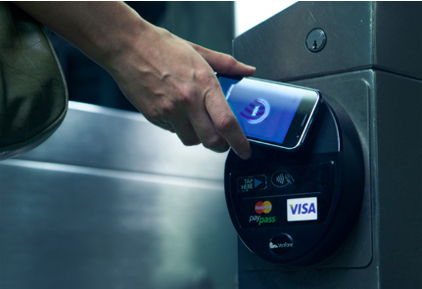
|
| As with other home security and automation applications, breakthroughs on the consumer side, such as payment apps, will boost other uses by electronic home system contractors. Photo courtesy of PRNewsFoto/Newscom |
It turns out they can.
Thanks in part to technology called near field communication (NFC), the smartphone is now on steroids, with the potential to open a homeowner’s door, load a CD into the whole house audio/video system, or even “talk” with a NFC-enabled light bulb.
NFC allows for simplified transactions, data exchange and wireless connections between two devices in proximity to each other. At CEDIA 2011, Yale Locks & Hardware of Lenoir City, Tenn., told electronic home system contractors it is about to release residential NFC door locks based on the ASSA ABLOY “mobile keys” platform, which will allow homeowners to unlock and lock their doors with the wave of an NFC phone rather than with a key or security key card.
At ASIS International, another ASSA ABLOY firm, HID Global Inc., Irvine, Calif., showed off NFC-enabled smartphones that can open doors and access a computer network. It talked up a pilot program with Arizona State University involving about 30 students equipped with smartphones to open their residential doors.
In addition, Ingersoll Rand Security Technologies of Carmel, Ind., demonstrated at ASIS a smartphone used just like a smartcard (or proximity card), placed next to the reader to open a locked door. The technology uses NFC, and the firm believes that early adaptors will include college campuses and their residential facilities, among others. A video demo is at: http://www.youtube.com/watch?v=vikdpmGqon4
Of course, with any breakthrough, at the beginning at least, there are more brakes than throughs.
A homeowner must have a smartphone and not just a cell phone. And not all smartphones are NFC-enabled (manufactured with the NFC chipset built in). While many Android phones have the capability, iPhones, including the recently introduced 4 S, do not. So far, it is unclear how many smartphone makers will build in the NFC chipset. ABI Research suggests 35 million handsets will be shipped this year, and double that next year. IHS iSuppli suggests about 550 million handsets by 2015. Meanwhile, Berg Insight AB expects there to be 400 million handsets by 2015.
No doubt, the growing popularity of NFC on the consumer side will accelerate use in homes.

|
| Residential applications such as college dormitories are a likely site for locks that are NFC-enabled, including this technology from Ingersoll Rand Security Technologies. |
Obviously, some of that growth will come from the growth of the chips in smartphones. There will be more carrier-side demand and end-user interest in NFC, thanks to the decrease in cost of the chipsets and the increase in myriad applications, says Harry Wang, director of health and mobile product research at Dallas-based Parks Associates. “This includes digital locks and replacement of ID cards. It continues to be intriguing how people are using smartphones in more and more diverse ways.”
Whatever the number and speed of growth, NFC will be driven, in the short term, not by access control and home automation but by payment and micromarketing applications, according to Dr. Tam Hulusi, senior vice president of strategic innovation with HID Global.
In Europe and the Pacific Rim, people with NFC smartphones can pay for goods at stores and from vending machines, board a train or airline, and make new friends at the local Hello Kitty store, thanks to technology-smart posters and tags. NFC tags are passive devices used to communicate with active NFC devices.
NFC will never be a home area network as compared to communications schemes such as ZigBee, Z-Wave or Wi-Fi. It’s mostly a one-to-one deal.
The biggest installer of ZigBee beyond electric utilities, Control4’s Eric Smith, chief architect and one of the Salt Lake City, Utah, company's co-founders, tells smartHOME he’s thinking about NFC.
For example, says Smith, for electronic home system contractors and their installers, an NFC phone can become a useful tool for configuring. “With such a mobile tool, an installer can walk around and more easily commission” various networked appliances and devices, comments Smith.
At the present time, it’s fanciful, according to Smith and others, that a homeowner with a NFC-enabled smartphone in hand will walk through his or her property adjusting lights, turning on a movie, or controlling energy. But it may make sense for the smartphone to “authenticate the homeowner, log into the touchscreen, and even authenticate a dealer” when he or she has work to do, says Smith.
Still, “from a residential perspective, the mobile phone is ubiquitous,” Jason Williams, general manager of Yale Residential, said at the CEDIA Expo. “We use it to make reservations, schedule our day, everything. By incorporating NFC technology into our Yale Real Living locks, we've extended the functionality of the mobile phone even further.”





